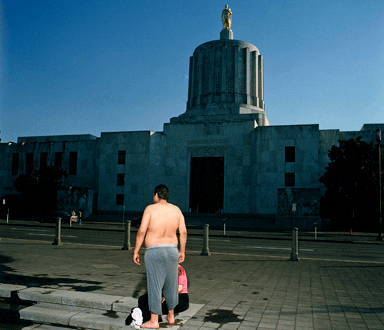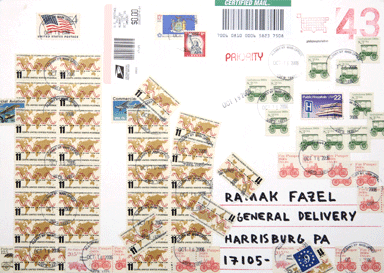|
|
||
|
The homepage of the Storefront for Art and Architecture’s website bears the image of a ubiquitous post-9/11 directive issued by the New York City Police Department and the Metropolitan Transportation Authority: “IF YOU SEE SOMETHING, SAY SOMETHING.” The image links to information on the Storefront’s exhibition 49 State Capitols, the photographic and philatelic (postage stamp-loving) essay of artist Ramak Fazel’s 2006 pilgrimage to all of the United States’ capitol buildings, save Alaska’s. Almost halfway into his trip, Fazel made a capitol visit that necessitated him leaving behind the Chevy Starcraft conversion van that served as his mode of transport and home for the duration of the journey and taking a flight to Honolulu. On his return, he found himself describing the project to his seat-mate. Apparently that passenger saw something in Fazel – his middle-Eastern (good) looks? his (charming) accent? his (exotic) Iranian name? – and decided to say something… to the authorities. From that point on, Fazel’s pilgrimage took on a decidedly Kafkaesque turn: he was questioned in 15 states, handcuffed in two, read his Miranda rights (which usually accompany arrest), denied travel visas, interrogated at airports and otherwise harassed. Oh, and Ramak Fazel is an American citizen.
Perhaps it is inevitable that such a time-bound autobiographical project of the sort embarked upon by Fazel would emerge into the light of day with stories of the road, of people met and small obstacles overcome. But the story that accompanies 49 State Capitols casts the project in a decidedly malignant light. When the project began, it was all rather benign – the idea of travelling around the United States to visit an architectural landmark in each state is innocent enough. Pair that with sending postcards to oneself as a means to structure the journey, and using a childhood stamp collection as postage, and the endeavour turns downright sentimental. But given Fazel’s treatment at the hands of the authorities, each of his photographs from the journey takes on a rather sinister pall. In Austin, Texas, for example, Fazel’s camera captures a formation of state troopers in white gloves and full dress uniforms. Though they form part of a funeral procession for the late, great Texas governor, Ann Richards, the militarism of the scene is inescapable. In Salem, Oregon, Fazel frames a column fragment to capture its echo of the modernist neoclassicism – read brutalist – rotunda design of the capitol building itself. Such are the physical manifestations of state power, with which Fazel became all too familiar on his journey. Other images show flags and statehouse guards, yellow caution tape, Asian tourists, cleaning crews, empty lots and parked cars near the capitol grounds. From looking at one image to the next, what begins to dawn on the viewer is that Fazel has documented not so much his own quest to “know” the States, but a distinct kind of American vernacular. It is one that has been stripped of all of its romanticism because it has lost whatever modicum of innocence, which, however tenuously, it once possessed. 49 State Capitols is at the Storefront for Art and Architecture, New York, 22 January – 8 March
|
Words Jonathan Neil |
|
|
||






















